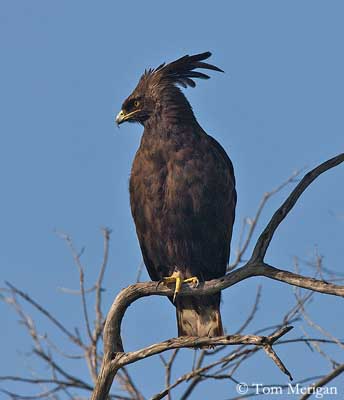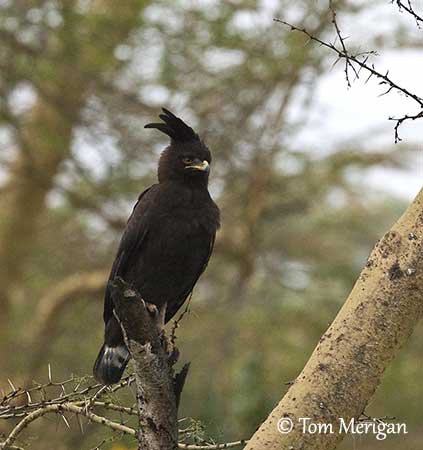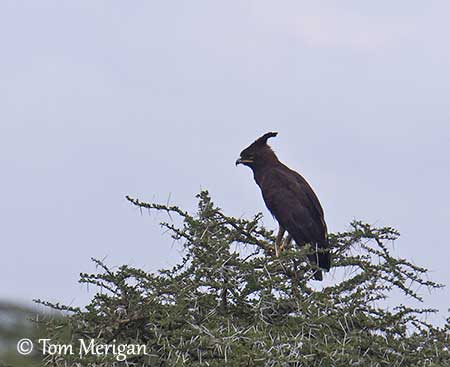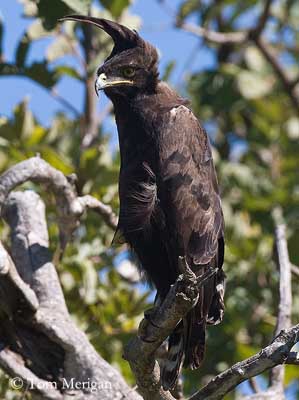
Long-crested Eagle
Lophaetus occipitalis
Accipitriforme Order – Accipitridae Family
BIOMETRICS:
Length: 53-58 cm
DESCRIPTION:
Long-crested Eagle adult is dark brown or black. It has long white patches at the joint of the wings, visible when perched, forming white lines on each side of the breast. Underwing coverts are white, with black spots. It has broad dark tail strongly barred of white. Tarsi are whitish. Wings are long and broad.
Hooked bill is yellow with dark tip. Eyes are golden or reddish-brown. Feet are yellow with slender talons.
In the first weeks after hatching, female remains or on near the nest while male brings food. After three weeks, female hunts more than male.
Young reaches its plumage at about 28 days, and remains around the nest from 40 to 50 days. It performs its first flight at about 55 days. Then, it moves rapidly away from the site. It is fed by both parents another two weeks.
This species produces one single brood per year, with only one chick per nest. Probably the older kills the other.
DIET:
Long-crested Eagle feeds mainly on small mammals, and also lizards and small snakes, and occasionally, it takes young poultry.
PROTECTION / THREATS / STATUS:
Long-crested Eagle is beneficial to human, killing any small rodents.
This species is widely distributed in Africa, except in the arid NE of the country.
Not globally threatened.
Fr: Aigle huppard
All : Schopfadler
Esp: Águila Crestilarga
Ital: Aquila dal lungo ciuffo
Nd: Afrikaanse Zwarte Kuifarend
Russe: Гребенчатый орёл
Photographer:
Tom Merigan
Tom Merigan’s Photo Galleries
Text by Nicole Bouglouan
Sources:
HANDBOOK OF THE BIRDS OF THE WORLD Vol 2 by Josep del Hoyo-Andrew Elliot-Jordi Sargatal - Lynx Edicions - ISBN: 8487334156
BIRDS OF AFRICA SOUTH OF THE SAHARA by Ian Sinclair and Peter Ryan - Princeton University Press Princeton and Oxford - ISBN: 0691118159
The Hawk Conservancy Trust (Hilary Smith)

HABITAT:
Long-crested Eagle frequents woodlands or cultivated areas, and open lands with trees. It can be found in moist savannahs, and in cleared forest areas and forest edges, except in arid zones. We can find it from sea level to 3000 metres of elevation.
RANGE:
Long-crested Eagle is found in Africa, South of Sahara, from Senegal to Ethiopia, and southwards, to the Cape.
BEHAVIOUR:
Long-crested Eagle feeds mainly on small rodents. It drops from an exposed perch on its prey, and catches it. It does not hunt on the wing.
It is often perched on trees on the road sides, fences or telegraph poles. It hunts generally in the early morning or at dusk, and it rests during the day under the shadow of a tall tree.
Pair has usually a regular area where they can be seen day after day.
Long-crested Eagle is very noisy when it displays. It calls from perches, around the nest site. Usually, it uses the same perch every day.
Long-crested Eagle is fairly common resident in Africa, in the eastern areas.
FLIGHT:
Long-crested Eagle soars at up to 300 to 500 feet above its area. It does not perform flight displays or striking flight movements. The display is only noisy.
REPRODUCTION:
Long-crested Eagle’s nest is often located in a river valley with large trees. Nest is built at height from 20 to 60 feet or more, in a large tree, such as wild fig or Eucalyptus.
Nest is made with small sticks. A deep central cup is lined with green leaves. Nest is well protected from the sun, in the middle of the tree, in a fork or a lateral branch.
It is built by both adults, and is used year after year, for some years.
Female lays one or two dull white eggs, spotted with brown and grey, in the second half of the dry season. During incubation period, female is fed by the male, near the nest. But she leaves the nest to hunt herself sometimes.
Male stays near the nest, roosting in the same tree, or close by. tened.
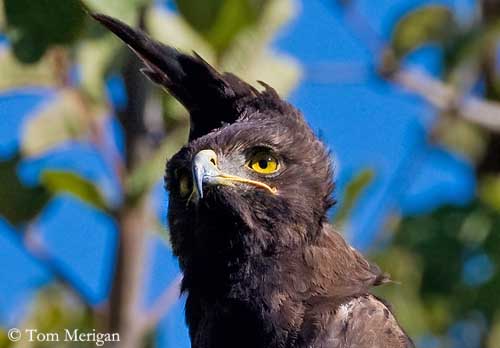
Immature is similar to adults, but browner. Wing coverts and neck feathers show white tips. Crest is less prominent. Eyes and feet are duller.
VOICE: SOUNDS BY XENO-CANTO
Long-crested Eagle is a noisy bird, as well on perch as flying, especially at the beginning of the breeding season.
It utters loud and sharp calls, and some shrill “kik-kik-kik-kik-kik-kiii-ih”.
Call’s display is a loud and clear “keeee-eh” or “keee-ee-af”.
